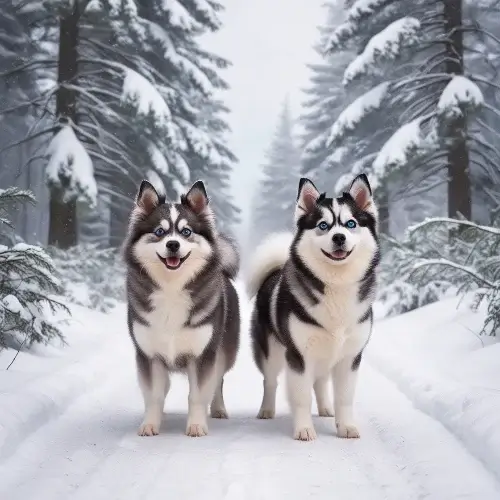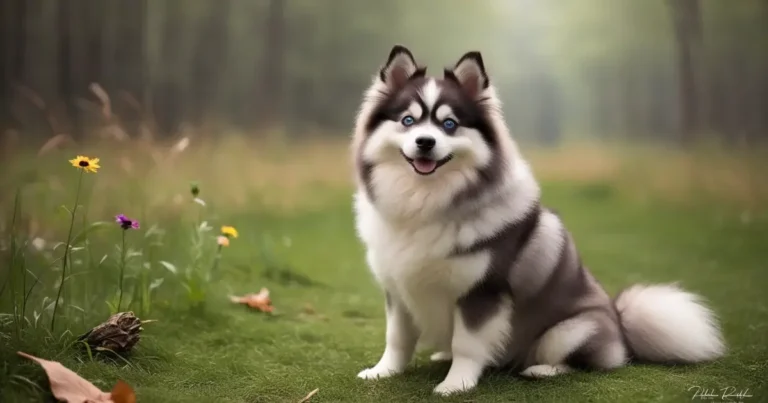Do Pomskies Like Winter Weather? A Helpful Seasonal Guide

Pomskies are adorable, small dogs that are a mix between Pomeranians and Siberian Huskies. With their fluffy coats and charming personalities, many people wonder, “Do Pomskies like winter weather?” The answer isn’t as simple as it seems. While their Husky genes might suggest they enjoy the cold, their size and sensitivity can tell a different story.
In this blog, we’ll explore how Pomskies adapt to winter, why they may not enjoy the cold, and how to care for them during chilly months. Let’s dive in!
Table of Contents
Understanding Pomskies and Their Adaptation to Winter
Are Pomskies Cold-Weather Dogs?
At first glance, you might think Pomskies love winter because of their fluffy fur and Husky lineage. But the truth is that they are not naturally suited for extreme cold. I often describe them as “pocket dogs who aren’t equipped for harsh winters.”
Here’s why Pomskies aren’t cold-weather dogs:
- Small Size: Their small bodies lose heat faster than larger dogs.
- Thin or Varied Coats: Some Pomskies inherit thinner coats from their Pomeranian side, making them less resistant to cold.
While some Pomskies may enjoy mild winter weather, prolonged exposure to extreme cold can make them uncomfortable or even sick.

Travel Considerations for Winter Weather
Pomskies are small and lightweight, which can make walking in deep snow or icy conditions challenging. To help them, many owners carry them in insulated carriers or small bags.
I’ve often said, “They normally travel in pockets during such weather.” This keeps them warm and safe from the harsh conditions outside. For short trips, carrying your Pomsky might be the best option to keep them comfortable.
Why Pomskies May Dislike Winter Weather
Issues with Wet or Cold Feet
One of the biggest challenges Pomskies face in winter is keeping their feet warm and dry. “Some dogs hate getting their feet wet,” and Pomskies are no exception.
Snow and ice can be particularly uncomfortable for their delicate paws. Common problems include:
- Wet paws that feel cold and uncomfortable.
- Ice forming between their toes, which can be painful and hard to remove.
Challenges Walking on Snow and Ice
Snowy and icy surfaces can make walking difficult for Pomskies. The risk of slipping or developing frostbite is real. “Ice balls between their toes make it hard for them to walk,” and can even cause injuries.
To prevent these issues, it’s important to take precautions like limiting their exposure to cold surfaces and using protective gear.
How to Keep Pomskies Comfortable in Winter
Pomskies need extra care to stay warm and happy during winter. Here are some tips to protect them from the cold.
Protecting Their Paws
Pomskies’ paws are very sensitive to cold. Booties are a great way to protect their feet. They:
- Keep feet warm.
- Prevent ice from building up between toes.
However, it’s important to note that Pomskies may take time to get used to booties. Start by letting them wear booties indoors for short periods. Over time, they’ll associate them with comfort during outdoor walks.
| Benefits of Booties | Why They Matter |
| Keep feet warm | Prevents frostbite |
| Stop ice from forming | Reduces discomfort while walking |
| Protect against sharp ice | Prevents injuries |
Do Pomskies Need Sweaters in Winter?
Yes, sweaters or jackets can help keep Pomskies warm, especially if they have thin coats. Their small size makes them lose heat quickly, so adding a layer of protection is essential.
When choosing a sweater for your Pomsky, make sure it:
- Fits snugly but doesn’t restrict movement.
- Covers their chest and back properly.
- Is made of warm, soft material.
I’ve always found that “a good sweater can make all the difference for Pomskies in cold weather.”

Building Winter Tolerance
Not all Pomskies are used to cold weather. You can help them adapt by:
- Starting with short outdoor sessions to gradually build tolerance.
- Rewarding them with treats for positive behavior during walks.
- Ensuring they always have a warm place to return to after being outside.
Tips for Winter Travel with a Pomsky
Traveling with a Pomsky during winter requires preparation. Here are some helpful tips:
Keeping Them Warm on the Go
Pomskies are small enough to carry in insulated carriers or wraps. This keeps them warm and safe while traveling. Insulated carriers can also shield them from wind and snow.
As I’ve mentioned before, “Pomskies are pocket dogs, and they often feel most comfortable being carried during harsh winter days.”
Preparing for Winter Walks
For outdoor walks, keep these tips in mind:
- Limit the duration of walks to prevent overexposure to cold.
- Monitor your Pomsky for signs of discomfort, like shivering or lifting their paws.
- Always dress them appropriately with booties and sweaters.
Conclusion: Winter Weather and Pomsky Care
So, do Pomskies like winter weather? The answer depends on the situation. While they may enjoy short play sessions in the snow, their small size and sensitive paws mean they’re not built for prolonged exposure to the cold.
By using the right winter gear, keeping outings short, and providing a warm environment, you can ensure your Pomsky stays happy and healthy during the colder months. Remember, their comfort and safety come first, so always be attentive to their needs.
With these tips, your Pomsky can enjoy winter in their own special way—whether it’s a quick romp in the snow or being snuggled up in your arms.
FAQs
What are the best tips for protecting Pomskies’ feet in snow?
Use booties to prevent ice and snow from accumulating between their toes. Booties keep their feet warm and safe, reducing the risk of frostbite or discomfort. Gradually introduce your Pomsky to wearing booties for better acceptance.
Do Pomskies need sweaters in winter if they already have a fluffy coat?
Yes, even fluffy-coated Pomskies might need sweaters in extreme cold. Sweaters provide extra warmth and protect them from wind and snow, especially if they have thinner coats or spend more time outdoors.
Are Pomskies cold-weather dogs like their Husky ancestors?
No, Pomskies are not naturally cold-weather dogs despite their Husky heritage. Their small size and mixed coat thickness make them more sensitive to cold than purebred Huskies.
What are some essential winter care tips for small dogs like Pomskies?
Provide proper winter gear, including booties and sweaters. Limit their outdoor time, carry them during extreme cold, and monitor for signs of discomfort. Keep them warm indoors with cozy bedding and blankets.






